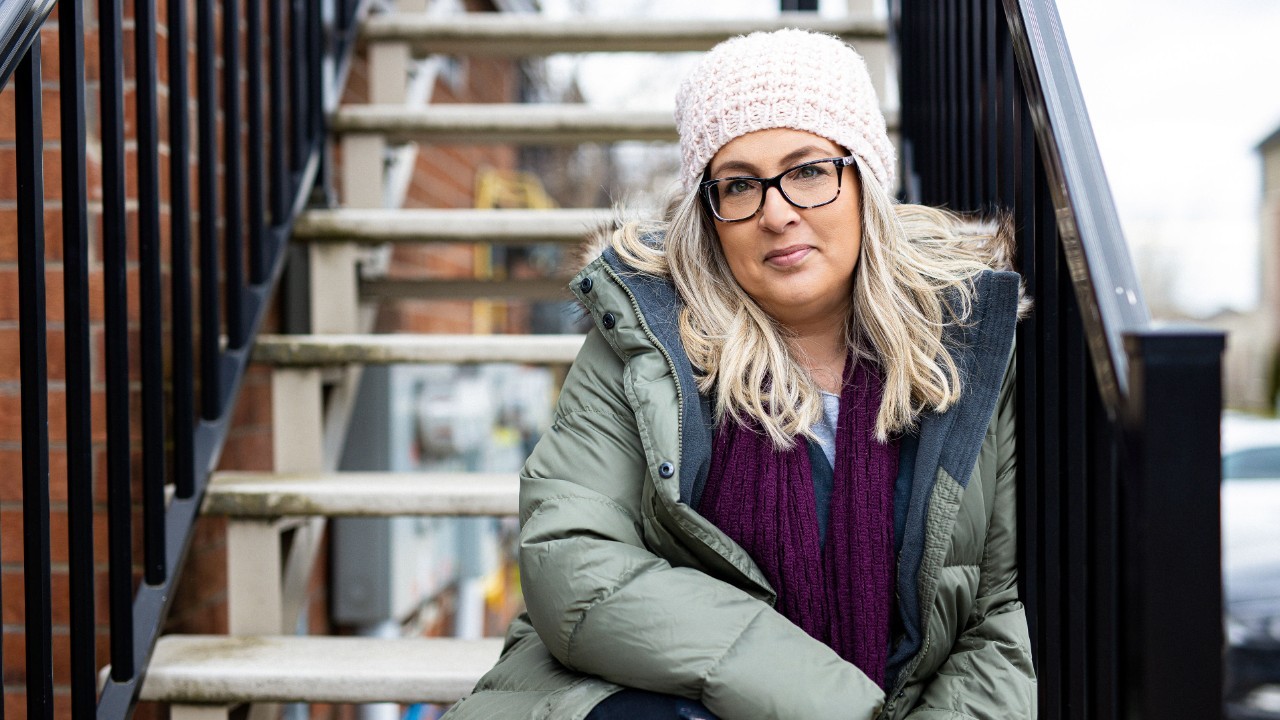- GBD 2017 Disease and Injury Incidence and Prevalence Collaborators. Global, regional, and national incidence, prevalence, and years lived with disability for 354 diseases and injuries for 195 countries and territories, 1990–2017: a systematic analysis for the Global Burden of Disease Study 2017. Lancet. 2018;392(10159):1789–1858
We hope to see you again soon!
You are now leaving Lundbeck UK's website (www.lundbeck.com/uk) for an external website. External links are provided as a resource to the viewer. Lundbeck UK are not responsible for the external website and its content.
UK-NOTPR-1010 | April 2022

Valerie Barogiannis
Out of the silence: speaking up about migraine
Valerie manages her chronic migraine with medication and lifestyle adjustments. Part of her migraine routine includes being more open and honest about her disease and its impact.
Valerie Barogiannis
Montreal, Canada
49 years old
Diagnosis
Valerie was diagnosed with migraine with aura in her early 20s. Her migraine evolved into chronic migraine and she’s now been living with the disease nearly 30 years.
Employment
Valerie is a business technology professional with Lundbeck. She joined the company in 2009, relieved to find a professional home where colleagues are understanding of her migraine and its impact on her schedule.
Retreating into quiet and dark spaces
Valerie Barogiannis has lived with migraine for decades, but it wasn’t until recently that she found her migraine voice. A Montreal resident who works in business technology at Lundbeck, Valerie experienced her first migraine with aura, or visual disturbance, when she was 21 years old. Since then, migraine has been a regular presence in her life, but she kept her experience mostly private, retreating into quiet and dark spaces to manage her migraine attacks alone.
Lately, though, Valerie has found strength in speaking more openly about her disease and sharing details of her migraine journey with a broader network of friends and colleagues.
“My close entourage has always known I have migraine, but I don’t think even they understand the depth and impact it has, above and beyond headache,” she says.
Valerie now shares her story to help people understand not just her personal experience, but migraine disease more broadly. With migraine affecting an estimated 1 billion people worldwide,1 chances are most people know someone living with migraine; and chances are, most don’t fully understand the full impact of the disease, Valerie says.
“The less we speak about it, the more people don’t understand,” she explains. “In the past, I would often push through an attack, smile plastered on my face, to avoid hearing things like ‘not again!’, ‘did you take some aspirin?’ Now, I take the opportunity to educate instead of masking.”
Suffering in silence
Valerie’s first migraine attack took her by surprise. She was dining at a restaurant when she saw a flash in one eye – a strobe that grew in intensity and size until she lost vision in that eye completely. “Truthfully, it freaked me right out. I thought I was losing my vision and had a friend rush me to the ER,” she recalls.
Valerie was referred to a neurologist and diagnosed with migraine soon after the attack. Diagnosis did not lead to a speedy recovery, however, and Valerie struggled for years with debilitating symptoms as she bounced her way through providers and treatments. “Neurologists, naturopaths, acupuncturists, and osteopaths,” she recalls. “And with that came a long list of treatments and remedies: low-dose antidepressants, prescription and over-the-counter medicines, ice packs, heating pads, ointments, vitamins and minerals, migraine trackers, change of diet and the list goes on.”
Like other people with migraine, stigma was also something Val experienced during that time. “You don’t wear a cast or a sling with migraine, and the symptoms aren’t obvious to those who haven’t lived it. For those of us living with it, it’s exhausting to explain and defend, so we often suffer in silence,” she explains.
Valerie felt the stigma significantly at a prior job that offered “no compassion or understanding, let alone flexibility,” she says. At the time, she was working at an IT service desk on a shift schedule. Every time she had to miss work due to a migraine, it impacted the rest of her team’s schedule. “The anxiety of calling in sick and what are people saying about me and not being considered reliable and dependable was very heavy,” she explains. “Eventually I chose to leave, and at Lundbeck I found compassion in my colleagues and like-minded people.”
Finding her voice
Today, Valerie manages her chronic migraine through a combination of medication and lifestyle adjustments. And part of her migraine management includes talking more openly and honestly about her disease. “It’s empowering to be able to educate and help people break the stigma,” she says.
She also expresses her feelings about migraine through her new hobby: painting. “I’m not a great artist, I don’t specialise in anything, but I had the urge to create something with my art that represented what I felt,” she says. “I recently started working on what I hope will become a series that I’m going to call ‘through migraine eyes.’”
Helping herself, helping others
Valerie admits it’s a little frustrating that the burden of stigma-busting and education typically falls to people living with migraine. “But if not us, who?” she asks. “People don’t know what they don’t know. I feel like the more I can put out there, the more I’m helping myself and others, too.”
"The less we speak about it, the more people don’t understand."
Valerie Barogiannis
More stories from Lundbeck
UK-NOTPR-2613 | August 2025